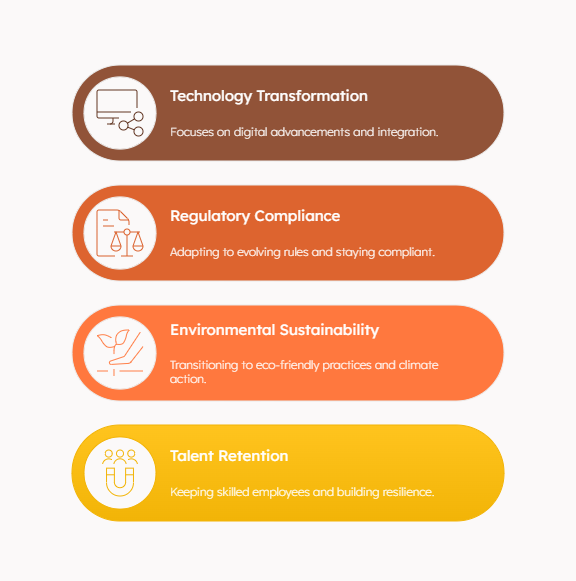Change Management
Organisational Change ManagementManagement
Contact us
Organizational and Culture Change
Guiding Change with Clarity, Confidence, and Culture at the Forefront
With uncertainty, volatility, and innovation defining today’s landscape, organizational development and change management is no longer optional. Yet whereas most companies react to disruption, few can lead systemic transformation that is strategic, inclusive, and sustainable.
At T3 Consultants a top management consulting firm, we support organizations across sectors in achieving deep, durable transformation through our business strategy consulting. Our approach is based on the latest global research, behavioural science, and real-world implementation experience, focused on delivering measurable impact by aligning structure, strategy, and culture.
“96% of organizations are undergoing some form of transformation today, yet only a third succeed in delivering their intended outcomes.” T3
Common Pitfalls That Derail Change Initiatives
- Only 25% of organizations say their senior leaders excel at managing change.
- Without visible, aligned leadership, change efforts lack credibility and momentum.
- 37% of employees actively resist change due to fear, fatigue, or confusion.
- Change efforts often ignore deep-seated norms, behaviours, and organisational rituals.
- Many transformations fail to tell a compelling story that answers “why now?” and “what’s in it for me?”
- One-way communications miss opportunities for dialogue and trust-building.
- Over 50% of change programs launch without clearly defined success criteria.
- Without outcomes and feedback loops, it’s impossible to course-correct in real time.
Our Approach to Successful Change: Insights from the Best Strategy Consulting Firm
Our business strategy consulting methodology integrates systems thinking, cultural diagnostics, regulatory alignment, and agile delivery, designed to help clients lead change that lasts. With deep expertise as a strategy consultant, we ensure every transformation aligns with long-term goals and regulatory demands.
Four key phases are outlined below:
We start with data and insight:
- Readiness and maturity diagnostics
- Stakeholder mapping and influence analysis
- Culture, conduct, and values audits
- Regulatory risk alignment
- A unified strategic narrative for the change
We build a transformation architecture that’s coherent, participatory, and measurable:
- Change governance (e.g. Transformation Boards, Change Offices)
- Programme and project plans tailored to your organization’s risk appetite and capabilities
- Behavioural design of nudges, incentives, and rituals
- Definition of KPIs linked to business value, compliance, and employee experience
We operationalise change through agile delivery models:
- Sprint-based implementation of initiatives
- Real-time dashboards to track adoption and resistance
- Change champion and leadership coaching networks
- Comms strategies that move from broadcast to conversation
- Course correction mechanisms and escalation pathways
We ensure momentum is maintained after go-live:
- Post-implementation audits and impact reviews
- Integration into HR, performance management, and leadership KPIs
- Design of training and capability pathways for internal change ownership
- Creation of playbooks, knowledge assets, and future proofed frameworks

Change Management Success Stories
Expert Organizational Change Consultant Solutions
1. Microsoft: Transforming Culture
When Satya Nadella took the reins as CEO in 2014, he kicked off a major cultural shift at Microsoft. The company moved away from a competitive “know-it-all” mentality and embraced a more collaborative “learn-it-all” mindset. This transformation put a spotlight on growth, empathy, and ongoing learning, which not only sparked innovation but also significantly boosted the company’s market value.
2. Adobe:
Transitioning to a Subscription-Based Model Adobe made a big leap from selling one-time software licenses to adopting a cloud-based subscription model with Adobe Creative Cloud. This shift demanded a complete overhaul of their organization, including new sales strategies and ways to engage with customers. The successful rollout of this model resulted in a steady stream of recurring revenue and stronger ties with customers.
3. Netflix:
Embracing a Culture of Freedom and Responsibility Netflix has built a unique organizational culture that thrives on high performance combined with freedom and responsibility. This approach has been crucial for the company’s ability to adapt and succeed. By nurturing an environment that promotes innovation and accountability, Netflix has skillfully navigated industry changes and kept its spot as a top streaming service.
4. HCL Technologies:
‘Employees First, Customers Second’ Philosophy Under the leadership of CEO Vineet Nayar, HCL Technologies adopted the “Employees First, Customers Second” philosophy. This strategy empowered employees and decentralized decision-making, resulting in higher employee engagement, improved customer satisfaction, and revenue growth. It’s a clear example of how focusing on employees can drive effective change management.
5. LEGO:
Rebuilding Through Innovation and Core Values After facing financial struggles in the early 2000s, LEGO decided to get back to basics by honing in on its core products and values. This focus on innovation, while staying true to its brand, helped the company bounce back, leading to consistent growth and profitability.
Business Priorities

Four Priorities : Change Management
1. Data & Technology
The incorporation of AI, automation, and digital platforms has become essential for staying competitive. However, the real challenge of transformation often lies not in the technology itself but in managing the change it brings. Take AI adoption, for example; it goes beyond just deploying models. It calls for re-skilling employees, establishing new decision-making frameworks, and fostering a culture that embraces machine-driven outcomes. Similarly, automation initiatives frequently face pushback, not because of technical hurdles, but due to fears about job security and control over processes.
- While data-driven change can enhance transparency, it also brings about accountability, which can shake up established power dynamics. Change leaders need to ensure that digital initiatives are supported by thorough stakeholder mapping, trust-building communication, and behavioral reinforcement at all levels of the organization.
2. Regulatory Change
Regulatory Change and Compliance In the UK and EU, regulatory change has become a constant presence rather than a periodic event. Financial services firms are now faced with ongoing compliance requirements related to ESG, AI, resilience (like DORA), and operational risk. In the past, regulation was often confined to legal and risk departments, but today’s regulatory landscape is more integrated and affects the entire organization. This shift means that compliance needs to be woven into daily decision-making, training business units to understand and respond to new regulations, and establishing feedback loops between compliance officers and operational teams. Companies that excel in this area can steer clear of fines and reputational harm, positioning themselves to leverage regulatory changes as a strategic advantage.
3. Sustainability and Climate Transition
With net-zero targets, ESG reporting, and climate disclosure requirements (such as CSRD and TCFD), companies are being pushed to rethink their supply chains, product designs, and how they allocate capital. However, sustainability efforts often fall short when treated as mere add-ons or public relations stunts. To make real strides, organizations need to undergo significant internal transformation. This involves re-evaluating how teams prioritize tasks, make decisions, and measure success. Boards and regulators are increasingly looking for concrete evidence, so companies must establish internal systems for accountability, scenario testing, and ongoing adaptation. Effective change management is crucial for uniting teams around sustainability objectives, enhancing internal understanding of ESG standards, and connecting environmental performance to incentive structures
4. Talent Retention
DOWNLOAD BASEL 3.1 GUIDELINE
Get your free copy of Basel 3.1 Guideline
Culture and Change Management Latest Stories
Our Impact on Culture and Change Management
We partner with organizations across the private and public sectors to spark the behaviors and mindset that turn change into value. Here’s some of our work in culture and change.
70% of change efforts fail poor communication and leadership buy-in are the top reasons.
Successful change leaders are 6x more likely to engage employees early and often.
Companies with strong change management practices are 3.5x more likely to outperform peers financially.
Only 34% of employees say they feel confident during major change — trust is a gamechanger.
Projects with effective change support (training, comms, leadership alignment) hit 95% of their objectives.
Change-savvy firms adapt 33% faster to market shocks and regulatory shifts.
WHO DOES IT IMPACT?
All firms looking to reduce cost
Asset Managers
Banks
Commodity House
Fintechs
Services we Provide

Strategic Cost Transformation
T3 Consultants assist businesses in undertaking comprehensive cost transformation programs, focusing on long-term efficiency and growth rather than just short-term expense cuts.
They specialize in eliminating waste, optimizing processes, and aligning costs with business strategy without undermining compliance with minimum standards or ESG targets.

Operational Excellence
T3 Consultants assist businesses in undertaking comprehensive cost transformation programs, focusing on long-term efficiency and growth rather than just short-term expense cuts.
They specialize in eliminating waste, optimizing processes, and aligning costs with business strategy without undermining compliance with minimum standards or ESG targets.

Strategic Cost Transformation
T3 Consultants assist businesses in undertaking comprehensive cost transformation programs, focusing on long-term efficiency and growth rather than just short-term expense cuts.
They specialize in eliminating waste, optimizing processes, and aligning costs with business strategy without undermining compliance with minimum standards or ESG targets.

Operational Excellence
T3 Consultants assist businesses in undertaking comprehensive cost transformation programs, focusing on long-term efficiency and growth rather than just short-term expense cuts.
They specialize in eliminating waste, optimizing processes, and aligning costs with business strategy without undermining compliance with minimum standards or ESG targets.
Frequently Asked Questions
- Project – The specific change initiative being implemented (e.g., digital transformation, regulatory compliance upgrades).
- Purpose – The strategic objective or reason for the change (e.g., improving efficiency, meeting new PRA/FCA requirements).
- Particulars – The details of how the change will happen (tools, processes, timelines, budgets).
- People – Stakeholders involved in or affected by the change, including employees, leadership, regulators.
5. Process – The structured approach to manage and implement the change (e.g., PROSCI ADKAR, Kotter’s 8-Step Model).
- Who Raised the change?
- What is the Reason for the change?
- What Return is expected from the change?
- What are the Risks involved in the change?
- What Resources are required to deliver the change?
6. Who is Responsible for the build, test, and implementation?
7. What is the Relationship between this and other changes?
- Diagnostic Assessment – Understand the client’s challenges and maturity (e.g., risk framework, regulatory compliance gaps).
- Strategic Planning – Develop bespoke solutions aligned to business goals and regulatory standards.
- Execution Support – Drive implementation through change management, PMO support, or interim leadership.
- Value Realization – Ensure measurable outcomes (cost savings, compliance, resilience improvements).
- Capability Building – Transfer knowledge and skills for sustainability.
These reflect foundational elements required for successful transformation:
- Leadership Alignment – Clear sponsorship and buy-in from top executives.
- Stakeholder Engagement – Active involvement of all affected parties.
- Communication – Consistent and transparent messaging throughout the change process.
- Capability Development – Training and upskilling to embed new ways of working.
These are echoed in regulatory frameworks, especially where conduct risk, accountability (SM&CR), or cultural change are focal points.
If you want truly to understand something, try to change it.
Kurt Lewin
Want to hire
Change Management Expert?
Book a call with our experts
Contact



